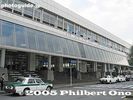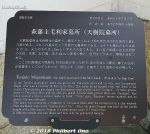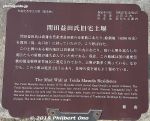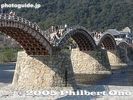 Image search results - "yamaguchi" Image search results - "yamaguchi" |

Gondola on left, castle on right.The castle is a short hike from the gondola station.
|
|

Kintai-kyo Bridge and Iwakuni Castle
|
|

The Kintaikyo Bridge originally led to the castle's front entrance.
|
|

Iwakuni Castle
|
|

The original castle was built by Lord Kikkawa Hiroie in 1608, after 8 years of construction. However, the castle had to be dismantled in 1615.
|
|
|

View from Iwakuni CastleKintai-kyo Bridge is visible.
|
|

Close-up of Kintai-kyo Bridge
|
|

In the background, you can see the stone foundation of the main tower where it was originally located. The current castle tower is a reconstruction and slightly south of the original location, making it more visible on the mountain.
|
|

Castle observation deck
|
|

Modern museum inside Iwakuni CastleIt is a museum.
|
|

Inside Iwakuni CastlePictures of famous bridges in Japan.
|
|
|
|

Iwakuni Station 岩国駅
|
|

Shin-Iwakuni Station 新岩国駅
|
|

Shin-Iwakuni Station
|
|

Shin-Iwakuni Station
|
|

Taxi fares from Shin-Iwakuni Station
|
|

Hagi Castle has no castle buildings remaining, but the moats and stone walls are impressive. Short walk from the Hagi Castle bus stop or Hagi Museum.
|
|

Hagi is a National Important Traditional Townscape Preservation District (重要伝統的建造物群保存地区).
|
|

After moving from Hiroshima, Mori Terumoto built Hagi Castle in 1604, and his Mori Clan rules Choshu domain here for about 260 years.
|
|

Mori Terumoto (1553–1625) was on the losing side at the Battle of Sekigahara, so his holdings were severely reduced and he had to move from Hiroshima to less central Choshu wher he built Hagi Castle.
|
|

Terumoto's humiliation angered the Mori Clan and Choshu domain which eventually helped to overthrow the Tokugawa shogunate in the 19th century.
|
|

Entering Hagi Castle grounds.
|
|
|
|
|

Hagi-yaki pottery shop.
|
|

Bridge to Hagi Castle. National Historic Site.
|
|
|
|

Hagi Castle, including the main tenshu tower, was at the foot of this mountain, Mt. Shizuki. It wasn't on top of the mountain. Flatland type. 指月山
|
|
|
|

The stone base for Hagi Castle's main tenshu tower.
|
|

About Hagi Castle.
|
|
|
|
|
|
|
|
|

Intertwining Pine Tree
|
|
|

Torii
|
|
|

Steps to go on Hagi Castle's main tenshu tower foundation.
|
|
|

Atop Hagi Castle's main tenshu tower foundation.
|
|
|

There's even a bench on Hagi Castle's main tenshu tower foundation.
|
|
|

Views from Hagi Castle's main tenshu tower foundation.
|
|
|
|
|

Views from Hagi Castle's main tenshu tower foundation.
|
|
|

Views from Hagi Castle's main tenshu tower foundation.
|
|
|
|

Views from Hagi Castle's main tenshu tower foundation.
|
|

Adjacent to Hagi Castle is this Asa Mori Clan Residence.
|
|

Entrance to Asa Mori Clan Residence.
|
|

About Asa Mori Clan Residence.
|
|

Asa Mori Clan Residence was a longhouse of rooms.
|
|

Scale model of Hagi Castle.
|
|
|
|
|

Samurai armor.
|
|
|

Gift shop and parking lot at Hagi Castle.
|
|

Hagi Youth Hostel designed like a castle.
|
|
|
|
|

Maaru bus stop at Hagi Castle.
|
|

Tenjuin Mausoleum
|
|

Tenjuin Mausoleum entrance. The graves of Mori Terumoto and his wife. There used to be a temple here, but only the graves remain.
|
|

About Tenjuin Mausoleum.
|
|
|
|
|
|

Grave of Mori Terumoto.
|
|

The graves of Mori Terumoto and his wife.
|
|

Grave of retainer Motofusa Nagai and his loyal cat.
|
|

About Motofusa Nagai and his loyal cat.
|
|
|
|
|

Vestiges of the castle town remain here with white walls.
|
|

Traditional townscape in Hagi, Yamaguchi.
|
|

Front gate of Mori Clan's detached residence.
|
|
|
|
|
|

Nice traditional townscape in Hagi, Yamaguchi.
|
|

Mud wall of Toida Masuda residence.
|
|

Mud wall of Toida Masuda residence.
|
|
|
|

Even modern homes have white walls.
|
|
|
|
|
|
|

This road goes to Hagi Museum.
|
|

Shoin Shrine is dedicated to Yoshida Shoin (1830–1859 吉田松陰), a native of Hagi who was a leading intellectual and educator during the final years of the Tokugawa shogunate.This is the first torii.
|
|

Yoshida is also noted for trying to stowaway on Commodore Perry's USS Powhatan flagship to go to America and study abroad in 1854. He had an eventful but short life, executed at age 29. In Hagi, the Shoin Shrine is dedicated to him.
This short path to the shrine has various monuments.
|
|

Giant ema wooden prayer tablet with a picture of Yoshida Shoin (right) and student Yamagata Aritomo who became the father of Japanese militarism.
|
|

In 2018, Hagi is celebrating the 150th anniversary of the Meiji Restoration.
|
|

Marker for the Shoka-sonjuku school as a historical site.
|
|

About the the Shoka-sonjuku school.
|
|

Yoshida's poem.
|
|

QR code for more info in Japanese.
|
|

About the the Shoka-sonjuku school.
|
|

Shoka-sonjuku school. 松下村塾
|
|

Pictures of the school's famous students.
|
|
|

Shoka-sonjuku school. 松下村塾
|
|
|
|
|

Shoka-sonjuku school lecture room.
|
|
|

Portrait of Yoshida Shoin in Shoka-sonjuku school. He taught at the school for only a year. 松下村塾
|
|

Yoshida Shoin's living quarters.
|
|
|
|

Yoshida Shoin was confined here in 1855 after being arrested for trying to stowaway on Perry's ship.
|
|

About Yoshida Shoin's confinement.
|
|

Yoshida Shoin was confined here in 1855.
|
|
|

The school building is the original from Yoshida's days.
|
|
|
|

Shoin Jinja Shrine torii.
|
|
|
|

Shoin Jinja Shrine dedicated to Yoshida Shoin. 松陰神社
|
|

Inside Shoin Shrine
|
|
|

Adjacent to Shoin Shrine is Shomon Shrine that worships the students of Yoshida Shoin. 松門神社
|
|

Shomon Shrine 松門神社
|
|

About Shomon Shrine. 松門神社
|
|
|
|

Wishes on a pine tree.
|
|

Amulet shop
|
|

Shrine amulets.
|
|

Ema wooden prayer tablet.
|
|
|
|

Exiting the shrine's torii.
|
|

Monument indicating a visit by the Emperor and Empress and Crown Prince and Princess.
|
|

Filial piety bamboo.
|
|

Mori Shigetaka's tea room in his villa.
|
|

Monument indicating this place as where the Meiji Restoration started.
|
|
|

Happy New Year 2018
|
|

Yoshida Shoin History Museum is also within the shrine grounds. 吉田松蔭歴史館
|
|

Yoshida Shoin's family tree.
|
|

Yoshida Shoin's family when he was a child. (Sugi family)
|
|

Yoshida Shoin with his brother and father.
|
|

Shoin listening to a lecture at the school that hr would later take over.
|
|

Teacher, Mori clan head.
|
|

Yoshida Shoin studying.
|
|

Shoin enters Sakuma Shozan school.
|
|

Commodore Perry's USS Powhatan flagship.
|
|

Commodore Perry's troops.
|
|

Yoshida Shoin riding on a boat to Commodore Perry's USS Powhatan flagship to try and stowaway to America.
|
|

About the Ansei Purge.
|
|

Shoin confined.
|
|

Shoin imprisoned.
|
|

Shoin to be executed. (The museum does not show the decapitation.)
|
|

Historical figures from Choshu (Yamaguchi).
|
|

Leaving Shoin Shrine.
|
|
|

Opened in 2004, Hagi Museum is in an impressive, traditional-style modern building. Features mainly local history of Choshu. The Maaru bus stops here. Get off at Hagi Hakubutsukan-mae. 萩博物館前
|
|
|
|
|

Old fire truck.
|
|

Hagi Museum entrance. Open 9 am to 5 pm every day. Admission charged.
|
|

Inside Hagi Museum.
|
|

Scale model of Hagi Castle.
|
|

About Hagi Castle.
|
|

Mori Terumoto headed the Mori Clan who ruled the Choshu domain.
|
|

Mori Terumoto headed the Mori Clan who ruled the Choshu domain.
|
|
|
|
|

Samurai armor
|
|

The Sankin Kotai route the Mori clan took to visit Edo.
|
|

Old map of Hagi.
|
|
|
|

Yoshida Shoin's travel route.
|
|

Gallery of notable people from Choshu/Yamaguchi.
|
|
|
|

An adjacent building is the Kurashi-no-Yakata. くらしのやかた
|
|

Kurashi-no-Yakata displays old everyday artifacts and billboards from the 1950s. くらしのやかた
|
|

Old shop signs.
|
|

Old billboards. Very eye-catching.
|
|

Old soda bottles like Fanta.
|
|

Old billboards.
|
|

Old electric fans and TVs.
|
|

Old tape recorder.
|
|

Hagi Museum is also near Hagi Castle within walking distance. Also see the white walls.
|
|

Higashi-Hagi Station (東萩駅) is Hagi's main train station. JR San'in Line.
|
|

Inside Higashi-Hagi Station. Pretty quiet place. Less than 300 people per day get on the train here.
|
|

Model of Hagi Castle in front of Higashi-Hagi Station.
|
|

Bus stop at Higashi-Hagi Station.
|
|

Too bad this Hagi Station is not Hagi's main station. Very nice and vintage dating back to 1925. JR San'in Line.
|
|

Inside Hagi Station.
|
|

About Hagi Station.
|
|

Hagi Station platform.
|
|

Hagi Station platform.
|
|

Hagi Station platform. Only about 60 people per day now use this train station.
|
|

Hagi Station turnstile.
|
|

Hagi Station turnstile.
|
|
|
|

Hagi Station phone booth.
|
|

Hagi Station phone booth.
|
|

Hagi Station phone booth.
|
|

Railway monument in front of Hagi Station.
|
|

In front of Hagi Station is a statue of a young Inoue Masaru who was Japan's first Director of Railways or "father of the Japanese railways."Inoue Masaru was from Hagi and one of the Choshu Five who was smuggled out of Japan to study in the UK in 1863.
|
|

Next to Hagi Station is this tourist information office.
|
|

Inside Hagi Station tourist information office.
|
|

JR Iwakuni Station is closest to Kintaikyo Bridge, a short taxi ride.
|
|

In front of JR Iwakuni Station is a model of Kintaikyo.
|
|

Even the roof of the local shopping street near Iwakuni Station has a Kintaikyo design.
|
|

Kintaikyo Bridge manhole in Iwakuni, Yamaguchi
|
|

Hiroshige's woodblock print of Kintaikyo Bridge from his "Famous Views of the 60 Provinces" series.
|
|

Epicenter of the bomb that fell on Iwakuni during World War II. In front of JR Iwakuni Station.
|
|

About Kintaikyo Bridge in English. Made of wood with five distinct arches, Kintai-kyo Bridge is one of Japan's three most famous bridges since the 17th century.
|
|

The current Kintaikyo Bridge was reconstructed in Feb. 2004 after 3 years of work by Iwakuni carpenters using Edo-Period techniques and materials from all over Japan. It is slated to last for 50 years.
|
|
|
|
|

Kintaikyo in Iwakuni, Yamaguchi
|
|
|
|
|

Kintai-kyo Bridge, Yamaguchi
|
|
|
|
|
|
|

Panoramic shot of the Kintaikyo Bridge area.
|
|
|

Guide map to Kintaikyo area and how to get to Iwakuni Castle atop the mountain.
|
|

Entrance to Kintai-kyo Bridge. Admission charged.
|
|
|
|
|
|
|
|
|
|
|
|
|
|
| 1018 files on 5 page(s) |
1 |
 |
 |
|